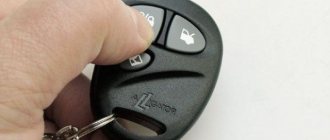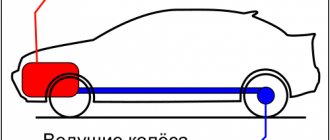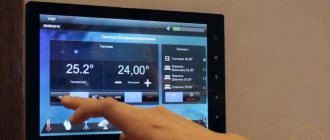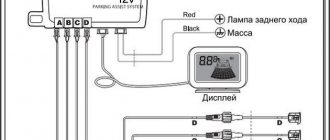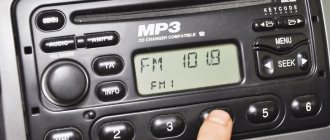How does ERA-GLONASS work on Lada Vesta?
Details Category: Articles Published 12/13/2015
Lada Vesta became the first car on the Russian market, which is standardly equipped with the ERA-GLONASS . How this system is implemented on the Lada Vesta will be discussed below.
The ERA-GLONASS system on the Lada Vesta is built into the lighting unit on the ceiling. In addition to the lighting itself, this side includes elements of the emergency response system:
- microphone
- speaker
- emergency call key
- emergency response system status indicator
Emergency services call system designed for automatic (in case of an accident) and manual call to the operator of the ERA-GLONASS .
A microphone and loudspeaker are used to communicate with the operator of the ERA-GLONASS .
The key to call the operator of the ERA-GLONASS is located in the interior lighting unit. It is a push-button switch with a non-fixed “on” position. The key press time for an emergency call is 2 seconds.
In standby mode (with the ignition on), the system carries out self-diagnosis, receives signals from the GLONASS and GPS navigation satellite systems, and constantly calculates the time, speed, direction of movement and coordinates of the vehicle's location.
In the event of an accident, if the airbags are deployed, the system generates a minimum set of data containing information about the coordinates and parameters of the vehicle’s movement at the time of the accident, the time of the accident, the vehicle’s VIN code and other information necessary for emergency response, and transmits it to the system operator “ ERA-GLONASS" . After transmitting the minimum set of data, the operator is dialed for voice communication. While dialing the operator, the backlight of the “SOS” key flashes red. When transmitting a minimum set of data and during voice communication with the operator, the backlight of the “SOS” key lights up continuously in red. When making a voice connection, the system turns off the sound reproduction of the multimedia system.
In addition to automatic activation in case of an accident, the system has a manual call function. A manual call can be made with the ignition on, as well as with the ignition off, if less than 72 hours have passed since the ignition was turned off. To make an emergency call manually, you need to press the “SOS” button on the interior lighting unit and hold it pressed for at least 2 seconds. If, during a call, you press the “SOS” button again and hold it for at least 2 seconds, the emergency call will be canceled.
↑ Era-GLONASS diagnostic system and its malfunctions
The complex runs a self-testing procedure that determines its functionality. The operation of the microphone, speaker, indicator, and communication with the operator must be checked. Before starting diagnostics, you must turn off the engine. Then the ignition is turned on and remains in this position for at least 60 seconds.
After 15 sec. The phrase will sound: “The testing system has been launched.” The indicator indicating the antenna lights up red. A few moments later, the phrase is heard from the speaker: “No errors detected. The microphone and speaker are being checked." You will then be prompted to “Say the passphrase.”
New Lada: Replacing brake fluid Lada Vesta
The end of testing is recorded after the words: “Enter the test result.” After which you will be prompted to re-switch the ignition switch “on” - “accessories” back and forth (interval no more than 3 seconds). If diagnosing the microphone and loudspeaker is successful, the phrase sounds:
The indicator, which had been glowing red all this time, goes out. During diagnostics, the call key flashes red during a call, and is constantly lit during a call. The multimedia system is switched off when there is a voice message.
Important! Malfunctions are determined by the operation of the key and indicator lamps.
To determine the performance of ERA-Glonass, you must wait 60 seconds. after turning on the ignition.
If there is no connection with satellites, the backlight of the call button first lights up in white in standby mode, and during dialing and voice communication it lights up in red. The indicator does not respond when turned on.
When the battery is low and there is no ignition, the key lights up first white and then red. The indicator does not turn on.
If there is no connection with the operator, the key and indicator light red.
A malfunction of system components can be indicated by the red illumination of the SOS button and the blinking of the indicator in the red range.
Why do I need GLONASS in my phone?
Almost everything, even very budget smartphones, are equipped with GPS. However, GLONASS is not so popular among smartphone manufacturers. But GLONASS support is becoming popular among mobile gadgets over time. This is done, first of all, to improve communication during navigation. As described above, using two technologies at once will provide better navigation throughout the world.
Is it worth looking for a smartphone with GLONASS support? Technology is useful, but only to those people whose lives are focused on navigation. First of all, these are drivers, travelers, and so on. If you often use map, radar, navigation and similar location-related functions, GLONASS will improve the performance of these elements. But only in some places where GPS cannot cope. By the way, there are few such places. In Russia, GPS “dead” spots are more common, but they are insignificant. If navigation is very important, then GLONASS will come in handy, but for the average user this technology is of no value.
How to find out if your smartphone has GLONASS?
To find out whether your device supports GLONASS, you can, for example, go to Yandex.Market and look at the characteristics for your smartphone. If it is indicated that GLONASS is supported, then it is. Just be careful: the manufacturer may produce several similar devices, some of which may have GLONASS support, while others will not.
In addition, you can find out about system support directly from the smartphone menu. To do this, go to the navigation system settings. If GLONASS is a separate item, it means that support for this navigation system is present.
Finally, you can install a program to test the navigation properties of your smartphone. You install it, launch it, go out into the open for a more accurate testing result, and wait a little while the application detects satellites. If your satellites include both GPS and GLONASS, congratulations—the device supports both navigation systems. GPS is usually indicated by an icon with an American flag, GLONASS - with a Russian flag.
Why do you need GLONASS in a smartphone?
A phone with a GLONASS navigator helps you determine the location of an object and get directions in two taps. Let's look at what GLONASS is in a phone and how satellite navigation works under normal conditions.
This type of orientation is useful for travelers. It is very easy to get lost in an unfamiliar city. The navigator will show the road and calculate a convenient route. By loading maps into the navigator’s memory, you can easily find your way to a store or cafe, even without access to the Internet.
Drivers will need smartphone navigation. You can find a shortcut to home or work and find out the distance. The navigator will correct the path and prevent you from getting lost; if you are distracted from the road, you will miss a turn.
If visibility on the road is poor (rain or fog), the tracker will indicate a turn or obstacle before you see it. Satellite navigation is being introduced into transport control systems. These are the programs “Wialon”, “Avtoscan”, “Autograph”, “ERA”. You will learn more about them and about them from the materials on our website.
Out of coverage: why the most popular cars do not need ERA-GLONASS
From January 1, 2020, the ERA-GLONASS system is mandatory for all new cars. Import of used foreign cars without it is now closed. But why do the most popular “our brands” do without “Era”, and it is theoretically possible to install a button on your own car, but in reality it is impossible?
ERA-GLONASS is considered a project of national importance, because so far such a system is just being implemented in Brazil, and the European analogue of eCall will become mandatory only in 2020. And ERA is already working: by the beginning of December last year, 93,931 calls were accepted in the system and 118,268 cars were registered (about half of them are Lada Vesta and XRAY - 65 thousand cars for 2020). True, in Russia, even out of all 30 federal highways, only 17 have GSM coverage by at least one cellular operator along their entire length. And in those places where the system does not pick up a signal, ERA-GLONASS is useless.
However, the transition period is over: starting from 2020, all cars “put into circulation”, that is, receiving a vehicle passport (PTS), must have the system. For example, at the end of last year, Ford was the first local automaker to report on the widespread introduction of “Era” on its models, including the Transit van family. Toyota and Kia made similar statements (“on any model from the beginning of 2020”), and Hyundai will equip almost the entire model line with Era, with the exception of the “old” Solaris (its successor with Era will debut in the spring), the i40 family (its will soon be replaced by the new Sonata) and H1 minibuses. The introduction of “Era” on Volkswagen cars will begin with the new Tiguan.
In 2020, 260 models were certified with Era, including commercial vehicles, which only require a device with manual activation of an emergency call. But many cars will gradually be equipped with SOS buttons. This opportunity is left to them by the peculiarities of the Russian certification process.
The fact is that PTS is issued on the basis of OTTS - a vehicle type approval certificate, which is issued for each individual model based on the results of certification tests and is valid for three years. If we take into account that many “old” OTTS were renewed at the end of 2020, it turns out that some cars without “Era” will retain market access at least until the end of 2019!
Full system certification with crash tests still costs a pretty penny, but the queues at the laboratory have decreased, and the Ministry of Industry and Trade allows you to combine crash tests and take the results of factory tests into account. All this slightly eased the burden for manufacturers, so there was no mass exodus of niche brands and models from Russia: ERA-GLONASS is already on Bentley Bentayga cars and will appear on the Maserati Levante, all Porsche models are equipped with SOS buttons, even Rolls-Royce is ready to implement the system. And premium brands such as Jaguar, Land Rover, Lexus, Mercedes-Benz and Infiniti have already done this. Even Aston Martin, Ferrari and Lamborghini are working. So far, only BMW coupes and convertibles of the second, fourth and sixth series, M4 sports cars, Z4 roadsters, BMW i8 hybrid cars, as well as Audi A5 and S5 convertibles have officially become victims of the “Era” - all these cars will no longer be supplied to Russia. But here’s the main paradox of “erification”: among legal evaders today, most of them are budget cars made in Russia!
In addition to the SOS button, each car with the ERA-GLONASS system has its own SIM card, antenna, modem, microphone, speaker and GLONASS navigation module. The photo shows a Hyundai Creta crossover terminal with a test call button. According to our data, the cost of the “Era” kit on a domestically assembled mass B+ class sedan is 15 thousand rubles, but for the client the estimated additional payment for “Era” as an option can be 30 thousand
ERA-GLONASS is not yet available on Kalina, Grant and Lada 4x4. In the basic equipment it will not be available on Logan, Duster and Sandero hatchbacks: this is possible, since all cars of the Logan platform in Russia are subject to a recently updated general certificate under the designation Global Access (as the B0 platform is called within the company). Nissan is introducing “Era” on the Murano, X-Trail, Qashqai, Terrano crossovers and on all Datsun cars, but the Nissan Almera sedan remains “unacknowledged”. And UAZ is going to produce Patriot without “Era” until 2020.
Interestingly, the government proposes to cut subsidies to those automakers that do not install the system - and make the presence of an SOS button a mandatory condition for admitting cars to government procurement. Therefore, some companies are planning... to offer it to customers for an additional fee! For this purpose, on those vehicles that, according to OTTS, have the right to produce SOS buttons, the ERA-GLONASS system is certified as additional equipment. That is, the buyer has a choice between a car with and without a button, and the manufacturer, formally observing the rules of the game, does not increase the cost of commercial vehicles, because voluntary demand for the “Era” will probably be small.
So far, only AvtoVAZ and Renault have confirmed to us that they are considering exactly this method of introducing “Era” for Kalina, Granta, Largus, Logan, Duster and Sandero. But theoretically, the SOS button can also be offered as an option by Kia Rio, Volkswagen Polo, Datsun and Ravon, Volkswagen Passat, Ford Focus and Ford Mondeo, Skoda Superb, Hyundai Santa Fe, BMW “five” and “seven”, BMW X1 crossover, sedans and crossovers Lexus, Genesis G80, Toyota Land Cruiser Prado, Mercedes Geländewagen and many, many other cars: in the OTTS they all have an emergency call system listed as “optional”. This gives manufacturers room to maneuver, but still does not mean that “Era” will not be “in the database” on these machines. For example, Volkswagen and Kia told us that the Polo, Rio and other models will have an SOS button as standard equipment.
The full version is available only to subscribersSubscribe now
I'm already subscribed
How to check GLONASS support
From the question of GLONASS in a smartphone - what is it, we move on to the next point: how to find out whether the phone supports the signal of the Russian constellation.
In this case, there are two options: go to the manufacturer’s website and study the characteristics of the model. Another way is to install an analyzer application for Android. Let's take a short overview of programs and functions:
1. “GPS-test” checks the supported system and measures the reception level. The utility displays the position of satellites in the sky, current location, speed and altitude. Geodata is transmitted by email or SMS. Records information in the form of diagrams and diagrams. 2. “GPS Status & Toolbox” will show which satellites the smartphone supports. 3. “GPS-Status Data” shows information about satellites, the signal quality of each of them. The program displays coordinates and time. To check which geolocation system works on your mobile phone: • open the “Location” section in “Settings”; • in the “Detection mode” item, check “By satellites”. • download any application from the list and run the scan.
In different applications, groups are marked with the colors of the national flag or shapes (triangle, square, polygon). If you see satellites marked with a tricolor or square, it means GLONASS is supported. If no system is detected during the test, repeat the procedure in an open area. It is possible that concrete floors are interfering with the signal.
Self check
To make sure that the system is working, there is no surer way than to get into an accident. Of course, a broken car is too expensive a price; ERA-GLONASS will also respond to pressing the panic button. In this case, an emergency call will be registered and voice communication with the dispatcher will be established. But these methods are somewhat destructive. You can check the system using a special test mode. Detailed instructions for this testing method:
- Keep the vehicle stationary for at least one minute.
- Check ignition position II.
- Press the buttons in the following sequence: 2 times - ON CALL, then 1 time - SOS, then three times - ON CALL and hold.
- One beep will sound.
- Say any word. Wait for the ERA-GLONASS device to repeat your phrase.
- This will be followed by two beeps and again a repetition of the expression you said.
- Next, three tones will sound.
- Press ON CALL to confirm quality or SOS if you did not hear the word you spoke.
- If the ERA-GLONASS system is working properly, the button will return to its original state. And in the event of a malfunction, the SOS will quickly flash and go out alternately.
For this method, it is important that you do not use the next 2 hours to communicate with the dispatcher. If you have already made a call and the car has not been deregistered, then testing will be impossible.
What is GLONASS in a smartphone and how does it work?
Now there are two constellations operating in full force in the world - GPS and GLONASS. GLONASS is the main competitor of the American group. The term stands for GLOBAL National Satellite System. The development of Russian technology began in the Soviet Union. The operating principle of the two constellations is the same.
The hardware part of the navigation structure consists of three segments:
• satellites; • ground stations; • receiver (navigator, telephone or terminal).
Let's talk about GLONASS in the phone, what it is and why it is being implemented.
A group of satellites emits a signal that contains the exact time. Constellations of different countries have different frequencies so as not to conflict with each other. The data packet travels to the receiver at the speed of light. The receiving device has a chip that receives information. The modem compares the time sent by the satellite and its own. Then it calculates the difference. Knowing the speed of the signal and the time spent, the receiver finds a point on the ground. To determine the location, information from four satellites is needed. Initially, this type of surveillance was intended only for military departments. Today it is used in the transport sector and smartphones of ordinary users.
How to make a mobile phone a tracking device
To track the location of an object, be it a car or your child's smartphone, you don't have to buy a tracker. By installing the “GPShome Tracker” mobile application, you can control the current position of the device.
So, GLONASS on the phone, how does the orientation program work? To transfer a data package, the Internet is required - Wi-Fi or a mobile network.
The connection algorithm is as follows:
1. Register on the developer's website. In the fields, write down your username and password, and enter your email address. Select the “Individual” checkbox and accept the user agreement. 2. A link will be sent to your email to activate your Personal Account. Go to the service and in the “Settings” window click “Add object”. Fill in the fields: “Name”; “Tracker IMEI” is the smartphone identifier; click “Save”. 3. In the smartphone settings, enable the “Location: satellite” option. 4. Download the utility from Google Play. 5. Open “Settings” and check the boxes “Enable tracker”, “Use network” and “Use GPS”. 6. For convenient use, the program is divided into three blocks: “Information”, “Maps”, “Settings”.
The first section shows the coordinates, the second section shows the current location. The application quickly eats up battery power, so disable it if not needed.
In the previous sections of the publication, we examined the question of what GLONASS is and why it is needed in a phone. Now let's see which models support the Russian and American groups.
The first phone that started receiving signals from our devices was the branded MTS Glonass 945. The smartphone ran Android 2.2 and had a 2 MP camera. In conversation mode the battery lasted 300 minutes. Sales started in March 2011, but were not successful. Having sold 5 thousand copies, ZTE, Sitronics and Qualcomm stopped production.
We present an overview of successful models of 2020 that can be ordered in online stores:
1. Let's start with the Samsung Galaxy S10+ phablet. The 6.4-inch screen is covered with protective glass Corning Gorilla Glass 6. Inside the flagship is an Exynos 9820 processor and 12 GB of RAM. The company equipped the smartphone with a record 1 TB of internal memory for storing files. In talk mode, the charge lasts 25 hours. 2. A more affordable option – Xiaomi Redmi 6A in a metal case. 5.4-inch display, 18:9 aspect ratio, HD resolution 1440x720. Works in 4G LTE cellular networks. The smartphone is controlled by the MediaTek Helio A22 chip. The main and front cameras are 13 and 5 megapixels. In addition to the indicated navigation systems, it receives the BeiDou signal. 3. The main highlight of the Russian smartphone YotaPhone 2 is its two screens. The front display is 5 inches, the back side is 4.7. Here you can find widgets for clock, weather, and notifications. One 8-megapixel camera works with two screens. 4. The operation of Huawei Honor 7A is controlled by the MediaTek MT6739 module and Android 8.1. Diagonal 5.45 inches with TFT matrix. “Catches” the signal of both systems, supports A-GPS for quick location determination. Battery capacity – 3020 mAh. The charge lasts a full day.
In conclusion, satellite navigation is a useful feature of modern phones. There is no need to buy extra devices, because this option is already built into the device.
The development of the Russian satellite navigation system, as in the case of the American GPS, began back in the 70s of the last century. GLONASS is an acronym for Global Navigation Satellite System. If a few years ago the bulk of its mentions were related to the launches of new satellites into orbit (both successful and not so successful) and jokes about this, then the state at the end of 2020 can be stated: GLONASS is working.
Which smartphones support GLONASS
The first smartphone to support the GLONASS navigation system was the Russian-Chinese model MTS 945, introduced in 2011. It did not gain popularity due to poor functionality and high cost. Other manufacturers did not waste time and began to build GLONASS receivers into their devices themselves. Since 2011, many products from Apple, Samsung, Xiaomi, Lenovo, Nokia and others have been equipped with support for the Russian navigation system.
The situation has been greatly simplified by the fact that most smartphone manufacturers do not develop and produce chipsets, radio modules and other high-tech components, but purchase ready-made chips from giants such as Qualcomm, Samsung or Mediatek. Therefore, when the next Exynos or Snapgragon chipset acquires GLONASS support, all devices built on its basis theoretically receive support for the Russian navigation system.
How to check GLONASS support
Unfortunately, the presence of theoretical support does not always mean such support in practice. Not everyone is in a hurry to realize the 100% potential of their product's hardware. This is often done in order to further emphasize the difference between budget and more expensive smartphones built on similar hardware. Therefore, to find out whether your device supports GLONASS, you need to install the free AndroiTS GPS Test Free program on your smartphone. It, as the name suggests, is designed to test the navigation capabilities of mobile technology.
By launching the program (with navigation turned on in the smartphone itself, of course) and being outdoors, you can watch how it finds navigation satellites. The satellites of the American GPS will be marked with the US Stars and Stripes, and the Russian GPS, respectively, with the tricolor. Of course, you don’t have to go outside, but it’s impossible to equip such a compact device as a smartphone with a powerful receiver. Many devices receive satellite signals very poorly through thick walls and ceilings.
How to use GLONASS
In order to use GLONASS, you do not need to perform any special actions. Most smartphone navigation software supports it by default. If such software is installed on your device out of the box, when launched it will automatically connect to both GLONASS and GPS satellites. If there is no navigation program on board, you can download the same GoogleMaps or Yandex.Maps from the market.
Why is this necessary?
The coverage of the satellites of both navigation systems today, although it is quite dense, it is impossible to ensure equally accurate location determination in different parts of the planet. In some places, GPS reception is better, in others - GLONASS. Maintaining communication with two systems at once allows you to reduce the number of “dead zones” where there is no reliable reception of one of them.
It is worth noting that GPS more correctly determines location in temperate and equatorial latitudes, where GLONASS is not highly accurate. At the same time, the Russian navigation system feels more confident in the northern regions of the planet. In any case, the combination of signals from both of them is definitely a plus.
mobcompany.info



